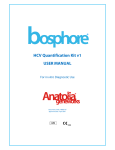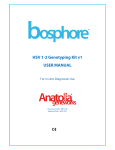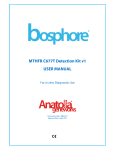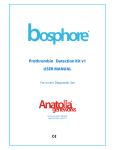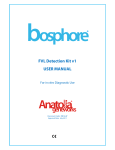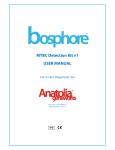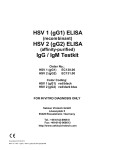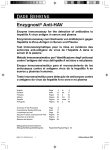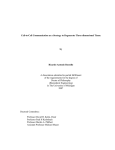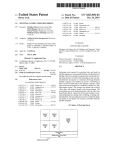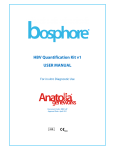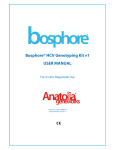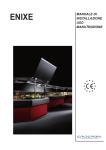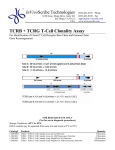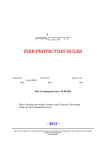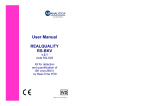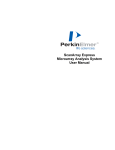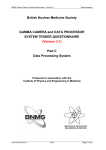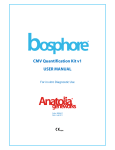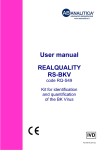Download BKV Quantification Kit v1 USER MANUAL
Transcript
® BKV Quantification Kit v1 USER MANUAL For in vitro Diagnostic Use ® Code: MB14v2f Date: December 2011 IVD Contents Page 1. Product Description 1 2. Content 1 3. Storage 1 4. Required Materials and Devices 1 5. Important Notes and Safety Instructions 2 6. Product Use Limitations 2 7. Pathogen 2 8. Method 3 9. Procedure 3 9.1. DNA Isolation 3 9.2. Kit Components 4 9.2.1. PCR Mix 4 9.2.2. Detection Mix 1 4 9.2.3. Detection Mix 2 4 9.2.4. Internal Control 4 9.2.5. Positive Control 4 9.2.6. Quantitation Standards 4 9.3. Preparing the PCR 4 9.4. Programming the Real-Time PCR Instrument 5 10. Analysis 5 11. Troubleshooting 8 12. Specifications 8 12.1. Sensitivity 8 12.2. Cross-Reactivity 8 13. References 8 14. Symbols 9 15. Contact Information 9 Code: MB14v2f Date: Dec 2011 ii Code: MB14v2f Date: Dec 2011 iii 1. PRODUCT DESCRIPTION Bosphore® BKV Quantification Kit v1 detects and quantitates four main genotypes of BK Virus DNA in human serum or plasma samples. The analytic sensitivity is 800 copies/ml. A region within the large T-antigene encoding gene is amplified and fluorescence detection is accomplished using the FAM filter. An internal control has been integrated into the kit in order to check PCR inhibition. The amplification data of the internal control is detected with the Cy5 filter. 2. CONTENT Bosphore® BKV DNA Quantification Kit v1 is composed of the following reagents: Bileşen 1 2 3 4 5 6 7 8 9 10 İçerik dH2O PCR Mix Detection Mix1 Detection Mix2 Internal Control Positive Control 1 Standard 1 (1 x 106 copies/ml) Standard 2 (1 x 105 copies/ml) Standard 3 (1 x 104 copies /ml) Standard 4 (2 x 103 copies /ml) 100 Test (1000 µl) (1375 µl) (210 µl) (55 µl) (15 µl) ( 45µl) (88 µl) (88 µl) (88 µl) (88 µl) 50 Test (1000 µl) (688 µl) (105 µl) (28 µl) (15 µl) (23µl) (44 µl) (44 µl) (44 µl) (44 µl) 25 Test (500 µl) (344 µl) (53 µl) (14 µl) (15 µl) (15 µl) (22 µl) (22 µl) (22 µl) (22 µl) 3. STORAGE Bosphore® BKV Quantification Kit v1 PCR reagents should be stored at -20°C. Repeated thawing and freezing (more than 3 times) should be avoided since it may reduce sensitivity. If the components are to be used in small amounts, they should be frozen in aliquots. While preparing the PCR; the components should not be exposed to room temperature for more than 10 min. and the detection mix components should not be exposed to light more than 1-2 min. We recommend preparing the PCR on a cooling block and keeping the detection mixes within a closed container. The components maintain their stability until the expiry dates on the labels, if they are stored at advised conditions. 4. REQUIRED MATERIALS AND DEVICES • Montania® 483 Real-Time PCR Instrument (Anatolia Geneworks), or another Real-Time PCR system with FAM and Cy5 filters (iCycler, iQ5, CFX–BioRad, LightCycler 1.5, 2.0, 480-Roche, 7500 Real-Time PCR System-ABI, Stratagene Mx3005P, Mx3000P-Agilent, LineGeneK, LineGene 9600-Bioer, Rotorgene 2000, 3000, 6000, Q-Qiagen) • 0.2 ml Thin-Wall PCR tubes, strips or PCR plates. • Magnesia® 16 Nucleic Acid Extraction System / Magnesia® Viral Nucleic Acid Extraction Kit (Anatolia Geneworks), or other high quality viral DNA extraction kits and systems • Deep freezer (-20°C) • Desktop centrifuge with rotor for 2 ml. microcentrifuge tubes • Calibrated adjustable micropipettes • DNAse, RNAse, pyrogen free micropipette tips with filters • DNAse, RNAse, pyrogen free 1.5 or 2 ml. microcentrifuge tubes • Disposable laboratory gloves Code: MB14v2f Date: Dec 2011 1 5. IMPORTANT NOTES AND SAFETY INSTRUCTIONS Important!: • The product should be delivered on dry ice. Check for presence of dry ice upon arrival. • Check for the expiry dates on the box and tube labels, upon arrival. Do not use expired products or components. • Calibrated or verified micropipettes, DNAse, RNAse, pyrogen free micropipette tips with filters, and DNAse, RNAse, pyrogen free microcentrifuge tubes should be used. • Before starting a test procedure, all components should be thoroughly thawed. After thawing, all components should be centrifuged briefly (spin-down for 3-5 seconds), and mixed well to ensure homogeneity prior to use. • The kit components should be kept on ice or a cooling block until the reaction is prepared, and they should be quickly returned to -20ºC. • PCR and nucleic acid isolation must be performed in different compartments. Samples should be stored separately to avoid contact with the kit components. • Pathogen information should be reviewed to be aware of the health related risks. • Biological samples should be handled with extreme caution: Physical contact with pathogens should be avoided by; wearing lab coats and gloves, no allowance for eating or drinking within the workspace, prevention of unauthorized individuals’ access to the working area. • All the pathogenic wastes produced during the nucleic acid isolation step; including the serum/plasma samples and material contacted with them, should be discarded into medical waste and disposed safely. 6. PRODUCT USE LIMITATIONS • This product should be used in accordance with this user manual. • This product is to be used by personnel specially trained to perform in vitro diagnostic procedures. 7. PATHOGEN Causative Agents BK virus (BKV) is a polyomavirus belonging to polyomaviridae family which is composed of an icosahadral viral particle (virion) containing 5000 base pair double-stranded circular DNA molecule and surrounded by a protein capsid. It does not possess a lipid envelope. BKV infections are asymptomatic as they remain latent in about 90% of the main human population and may lead to infections resulting in severe diseases such as of the immune system. There are 4 distinct genotypes of BK classified. [1], [2], [3] Epidemiology Most of the primary polyomavirus infections occur during childhood. Serological studies suggest that more than 70% of adults possess antibodies against BK virus. There are serological evidences suggesting the reactivation of the BK virus during the pregnancy period of 5-10 % of the women. [4], [5] Code: MB14v2f Date: Dec 2011 2 Modes of Transmission Although little is known about the route-of-transmission among humans, high infection rate suggests airborne transmission. Abundance of BKV in sewages also suggests transmission via contaminated food and water. Semen, blood products and organ transplantation, particularly renal allografts are other potential routes. [6] 8. METHOD Bosphore® BKV Quantification Kit v1 is based on the Real-Time PCR method. Polymerase chain reaction is a technique that is used for amplification of a DNA region. The reaction occurs by the repeating cycles of heating and cooling. The main components of PCR are primers, dNTPs, Taq polymerase enzyme, buffer solution and template. As a brief explanation, primers are small synthetic DNA those anneal to the specific regions of the template in order to start the synthesis. dNTPs are the building blocks of the amplified products. Taq polymerase amplifies the DNA template. Buffer solution provides the pH adjustment required for the reaction and template, as referred, is the target region for synthesis. In Real Time PCR technique, in contrast to conventional PCR, PCR product can be monitored during the reaction. Therefore Real-Time PCR obviates the need for further analysis methods like gel electrophoresis, whereby minimizing the risk of contamination. Dual labeled probes employed in the reaction in addition to the conventional PCR reagents, enable detection of the amplified target with increased sensitivity. The assay utilizes the 5’ exonuclease activity of Taq Polymerase to cleave a dual-labeled fluorescent probe during the extension phase of PCR. The probe is labeled at the 5’ end with a fluorescent ‘reporter’ molecule, and at the 3’end with another fluorescent molecule that acts as a ‘quencher’ for the ‘reporter’. When the two fluorophores are in close proximity, and the reporter is excited by light, no reporter fluorescence can be detected. During the elongation step of PCR, Taq Polymerase encounters and cleaves the probe bound to the template. As the reporter is freed from the suppressing effect of the quencher, fluorescence signal can be detected. The fluorescence generated by the reporter increases as the PCR product is accumulated; the point at which the signal rises above background level and becomes distinguishable, is called the threshold cycle (CT). There is a linear relationship between the log of the starting amount of a template and its threshold cycle, thus starting amount of unknown templates can be determined using standard curves constructed using CT values of the known starting amounts of target templates. Bosphore BKV Quantification Kit v1 employs multiplex PCR, and an internal control is incorporated into the system in order to control the isolation procedure and to check for possible PCR inhibition. BKV DNA and an internal control are co-amplified in a single reaction, using sequence-specific primers. The fluorescent signal generated by the BKV amplification is detected by a probe labeled at the 3’ end with FAM, through the FAM channel. The fluorescent signal generated by the internal control amplification, is detected by a second probe (labeled at the 5’ end with a different reporter molecule, Cy5) through the Cy5 channel. Code: MB14v2f Date: Dec 2011 3 9. PROCEDURE 9.1. DNA Isolation We recommend that the Magnesia® 16 Nucleic Acid Extraction System / Magnesia® Viral Nucleic Acid Extraction Kit (Anatolia Geneworks) isolation system, other high quality viral DNA extraction kits and systems are used with Bosphore® BKV Quantification Kit v1. The DNA isolation should be performed according to the manufacturers’ instructions. The recommended starting volume for Magnesia® Viral Nucleic Acid Extraction Kit is 400 µl and the elution volume is 60 µl. 9.2. Kit Components 9.2.1. PCR Mix HotStarTaq DNA Polymerase: HotStarTaq DNA Polymerase is a modified form of a recombinant 94 kDa DNA polymerase, originally isolated from Thermus aquaticus, cloned into E.Coli. The enzyme is provided in an inactive form. It is activated by a 15-minute 95 ºC incubation step. This prevents the formation of misprimed products and primer-dimers during reaction setup and the first denaturation step, leading to high PCR specificity and accurate quantification. PCR Buffer: contains Tris-Cl, KCl, (NH4)2SO4, 8 mM MgCl2, pH 8.7 (20ºC ). dNTP Mix: Contains ultrapure quality dATP, dGTP, dCTP ve dTTP/dUTP. 9.2.2. Detection Mix 1 Detection Mix 1 contains BKV-specific forward and reverse primers and a dual-labeled probe. 9.2.3. Detection Mix 2 Detection Mix 2 contains internal control-specific forward and reverse primers and a dual-labeled probe. 9.2.4. Internal Control An internal control is included in the kit to control PCR inhibition and possible problems. The internal control is a synthetic DNA molecule. It is added directly into the PCR master mix to control the PCR inhibition exclusively. For this purpose, 0.1 µl of internal control should be added for each reaction into the master mix. Lack of internal control amplification in the FAM negative samples, may indicate a problem in PCR or PCR inhibition. In this case, PCR should be repeated. In samples that contain a high viral load, internal control may be suppressed and no increase of the signal is detected. Please use the table below for the interpretation of internal control data: BKV (FAM) + + - 9.2.5. Internal Control (Cy5) + + - Interpretation Sample positive Sample negative Sample positive Repeat the test! Positive Control The positive control contains BKV DNA. It can be included in the PCR to test the efficiency of the PCR exclusively. The threshold cycle for the positive control is given in the acceptance criteria table (“Analysis” section). Threshold cycles higher than the acceptance criteria may indicate an efficiency loss in the reaction. 9.2.6. Quantitation Standards Quantitation of the viral load is performed using four quantitated DNA controls, ranging from 1 x 106 copies/ml to 2 x 103 copies/ml. 9.3. Preparing the PCR All four quantitation standards should be added into the PCR reaction together with the samples and the negative control (PCR-grade water). Make sure that all the kit components are thawed before use. Refer to the table Code: MB14v2f Date: Dec 2011 4 below for preparing the PCR. It is for only one reaction, multiply these values with the sample number to find the values required for the master mix. While preparing master mixes for more than 5 samples, an extra 10% should be added to the total sample number. 12.5 µl 1.9 µl 0.5 µl 0.1 µl PCR Mix Detection Mix 1 Detection Mix 2 Internal Control Sample DNA Standard Negative/Positive Control 10 µl Total Volume 25 µl Pipette 15 µl of the master mix into the PCR tubes, strips or plate wells, and add 10 µl of DNA (sample/ standard/positive or negative control). Close the tube cap/seal the plate carefully. Make sure that the solution in each tube is at the bottom of the tube/well. Centrifuge if necessary. 9.4. Programming the Real-Time PCR Instrument The thermal protocol for Bosphore® BKV Quantification Kit v1 is composed of an initial denaturation for activation the HotStarTaq DNA Polymerase, a two-step amplification cycle and a terminal hold. The real-time data is collected at the second step of the amplification cycle. Initial denaturation Denaturation Annealing and Synthesis (Data Collection) Hold 95°C 97°C 53°C 14:30 min. 00:30 min. 01:30 min. 22°C 05:00 50 cycles Before starting a Real-Time PCR reaction using the Bosphore® Kits, the following steps should be completed: • Choose the correct filters to be used (FAM and Cy5), • Identify unknown samples, standards, positive and negative controls, assign quantitative values for the standards, • Select the correct thermal protocol. 10. ANALYSIS By the end of the thermal protocol, the Real-Time PCR Instrument software automatically calculates the baseline cycles and the threshold. Examples of amplification curves are given in Fig. 1-2. Analysis of the results should be performed by trained personnel who have received the required training for analysing Real-Time PCR data. We recommend that the test results must be evaluated by an expert clinician, taking the patient’s clinical findings and the results of other tests into consideration. Code: MB14v2f Date: Dec 2011 5 Fig. 1: An Amplification Curve obtained using Montania 483 Real-Time PCR Instrument Fig. 2: An Amplification Curve obtained using RotorGene Q Real-Time PCR Instrument The standard curve is plotted using the data obtained from the defined standards, with the axes Ct-Threshold Cycle and Log Starting Quantity. Example of standard curves are given in Fig. 3-4. Fig.3: Standard Curve of a Bosphore® BKV v1 test performed using Montania® 483 Real-Time PCR Instrument Code: MB14v2f Date: Dec 2011 6 Fig.4: Standard Curve of a Bosphore® BKV v1 test performed using RotorGene Q Real-Time PCR Instrument All analysis is done automatically in routine use. However, when the trained personnel, who have received the required training from manufacturer, consider it as necessary, the system may allow adjusting the threshold as much as possible, for example in order to detect low positive samples. In this case, attention should be paid to keep the threshold line above the background and to keep the correlation coefficient at the maximum possible value (and within its acceptance criteria.) The table below displays the acceptance criteria for Bosphore® BKV v1. Component/Parameter Cycle Threshold (CT) Standard 1 28±2 Standard 2 31±2 Standard 3 Standard 4 Positive Control 34±2 36±2 33±4 Correlation Coefficient >0.960 PCR Efficiency >%60 Test results should not be reported unless the assay results meet the criteria stated above. Please contact the manufacturer if an impairment is observed in the product’s performance (See the last page for contact information). The quantitative results of the test are displayed on a spread sheet containing the calculated starting quantities of the unknown samples in each tube. Samples that cross the threshold in FAM filter are displayed with their calculated starting quantities; samples that do not cut the threshold are displayed as “Negative” or “No Ct”. These samples are regarded as negative or having a viral load below the detection limit of the assay. For these undetectable samples, the Cy5 data of the internal control should also be checked to avoid false negative results. The following table shows the possible results and their interpretation: Signal detected in FAM filter pair The sample contains BKV DNA, the result is positive No signal in signal in Cy5 The BKV DNA in the sample is not detectable FAM, No signal in FAM and Cy5 Code: MB14v2f Date: Dec 2011 The diagnosis inconclusive is No need to check the internal control since the sample is positive (high positive samples may suppress the signal from the internal control) Signal from Cy5 filter pair rules out the possibility of PCR inhibition No signal in Cy5 points out to PCR inhibition or to a problem in DNA isolation (See Troubleshooting) 7 11. TROUBLESHOOTING Please contact the manufacturer in case of a problem during a run. Late or no signal from the FAM filter Wrong thermal protocol is chosen Late or weak signal from the standards Deterioration of the standards or the core kit components No signal from the internal control Deterioration of the internal control or detection mix 2 PCR inhibition DNA lost during isolation Signal from FAM Filter in the Negative Control Contamination The Threshold is Above Low Signals The threshold should be manually adjusted Make sure that the correct thermal protocol is chosen. Don’t use expired standards or kit components. Follow the instructions for the storage of kit components (Section 3. Storage). Follow the instructions for the storage of kit components (See Section 3. Storage). Make sure that you use the recommended DNA isolation method (See DNA isolation). Make sure that you use the recommended DNA isolation method (See DNA isolation). Use filter-tips. Repeat PCR with new kit components. Using the mouse pull the threshold down until it cuts the low signals. Avoid the background and the signal from negative control. Uneven Traces Baseline cycles should be readjusted Assign new baseline cycles manually and recalculate threshold cycles. 12. SPECIFICATIONS 12.1. Sensitivity Analytical sensitivity may be expressed as the limit of detection: i.e. the smallest amount of the target marker that can be precisely detected. The detection limit of an individual analytical procedure is the lowest amount of nucleic acid in a sample which can be detected but not necessarily quantitated as an exact value. The analytical sensitivity or detection limit for NAT assays is expressed by the 95% positive cut-off value. The analytical detection limit for Bosphore® BKV v1 was found to be 800 Copies/ml. The sensitivity was determined using serial DNA dilutions. The dilutions were tested in different runs in replicates. The results were analyzed by probit method. 12.2. Cross-Reactivity To eliminate potential cross-reactivity, both assay design evidence and experimental studies were employed. Primer and probe sequences were checked for possible homology to other known pathogen sequences by sequence comparison analysis using database alignment. Samples of CMV, JCV, HBV, HSV, EBV, MTBC and Parvovirus B19 with known high positivity were tested, and found negative. 13. REFERENCES 1. Baron, Samuel. (1996). Medical Microbiology, 4th ed., The University of Texas Medical Branch at Galveston. ISBN 0-9631172-1-1. Code: MB14v2f Date: Dec 2011 8 2. Rajpoot DK, Gomez A, Tsang W, Shanberg A: Ureteric and urethral stenosis: a complication of BK virus infection in a pediatric renal transplant patient. Pediatr Transplant 2007, 11(4):433-5 3. Fioriti D, Degener AM, Mischitelli M, Videtta M, Arancio A, Sica S, Sora F, Pietropaolo V: BKV infection and hemorrhagic cystitis after allogeneic bone marrow transplant. Int J Immunopathol Pharmacol 2005, 18(2):309-16 4. Padgett BL, Walker DL: Prevalence of antibodies in human sera against JC virus, an isolate from a case of progressive multifocal leukoencephalopathy. J Infect Dis 1973, 127:467-470 5. Lukasik J, Scott TM, Andryshak D, Farrah SR: Influence of salts on virus adsorption to microporous filters. Appl Environ Microbiol 2000, 66:2914–2920 6. McQuaig SM, Scott TM, Harwood VJ, Farrah SR, Lukasik JO: Detection of human derived fecal pollution in environmental waters using a PCR-based human polyomavirus assay. Appl Environ Microbiol 2006, 72:7567–7574 14. SYMBOLS Use by Lot/Batch REF Catalog number Temperature limitation Caution, consult accompanying documents Manufacturer IVD In Vitro Diagnostic Medical Device 15. CONTACT INFORMATION ® Egitim Mh. Kasap Ismail Sk. No:10/23 Kadikoy 34722 ISTANBUL-TURKEY Phone: +90 216 330 04 55 Fax: +90 216 330 00 42 E-mail: [email protected] www.anatoliageneworks.com Registered Trademarks: Anatolia Geneworks® Montania®, Magnesia® and Bosphore® are registered trademarks of Anatolia Tani ve Biyoteknoloji Inc. Code: MB14v2f Date: Dec 2011 9












